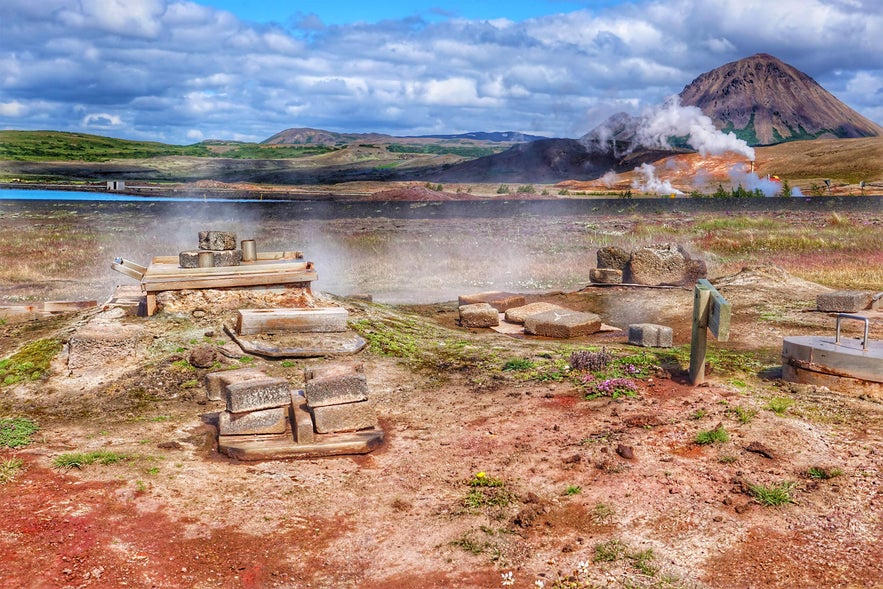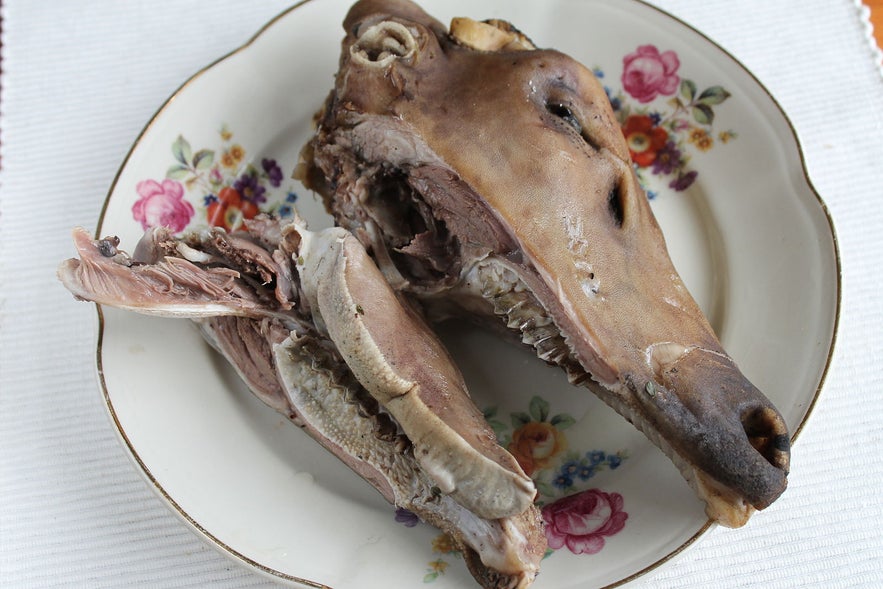
What is considered to be the most disgusting Icelandic dish? Where can you purchase your own sheep’s head or dig into a little-fermented shark? How can you persuade your taste buds that licorice is, in fact, delicious to some people? All will be revealed as we delve into the most disgusting food available in Iceland.
Photo from Wikimedia, Creative Commons, by Navaro. No edits made.
Why You Can Trust Our Content
Guide to Iceland is the most trusted travel platform in Iceland, helping millions of visitors each year. All our content is written and reviewed by local experts who are deeply familiar with Iceland. You can count on us for accurate, up-to-date, and trustworthy travel advice.
- Sample some of the best food in Iceland on The Reykjavik Food Walk
- Get to know some Delicious Icelandic Recipes
- Read about The Weirdest Things About Icelanders
Whereas a few traditional Icelandic dishes are considered a delicacy, commonly eaten by locals and tourists, there are some dishes you might not want to eat in Iceland — that is, unless you like a challenge. Adventurous travelers can book a food and drinks tour in Iceland to give it a shot.
Some people have gone on record to claim that the domestic cuisine here is the world's most disgusting food.
For centuries, Icelanders had to smoke, pickle, or dry their food in order to preserve it through the harsh winters. As a result, traditional Icelandic food mainly consists of seafood and lamb that's gone through some kind of preservation method.
Some of these time-honored dishes are now mostly eaten during Thorri midwinter feasts between late January to February, when traditional foods are still celebrated. Others remain part of everyday meals. Above, you can see Óli from the Guide to Iceland team helping a couple of guys from the UK to shop for and eat some traditional Icelandic food (spoiler: they don't seem to like most of it).
Luckily, though, Iceland is famed for its lamb and seafood, so there are plenty of delicious Icelandic foods to enjoy, too. If you want to get to know this unique cuisine, you can try it yourself with a food tour!
Fresh fruits and vegetables are a relatively recent addition, only becoming common in the last century. Today, the country prides itself on fresh ingredients, and there are a number of excellent restaurants in Reykjavik, as well as a Food and Fun Festival, where international chefs use Icelandic ingredients to come up with some truly delicious treats.
If you want to experience something a bit more traditional, you can rent a car to explore Iceland’s regions at your own pace. Stay in one of the country's best accommodations and try the following food items on your next trip to Iceland.
Insights Into Iceland's Famous Food
- Icelandic cuisine is rooted in survival, using preserved lamb, seafood, and every part of the animal.
- Some dishes like fermented shark, sour testicles, and blood pudding are considered extreme but are tied to cultural traditions.
- Others, like smoked lamb, rye bread, skyr, and meat soup, are widely enjoyed and still part of daily life.
- Food tours offer a great way to sample both the bold and the beloved dishes safely.
- Whether strange or interesting, Icelandic food reflects a rich, resilient heritage.
1. Hakarl (Fermented Shark)
You'll probably hear that the traditional way of fermenting a shark is to bury it in the ground and then urinate on it before letting it rot for some months. This is not entirely true.
The urinating bit is true, but the shark doesn't rot; it ferments. Additionally, urine is no longer used in this process, but it was used back in the day before modern culinary techniques could be used.
The shark does actually smell of ammonia, which is where the urban myth comes from. It has been cured through a specific fermentation process, which involves burying the shark underground and hanging it to dry for four to five months.
This is done to get rid of the acid in the flesh, which makes it impossible to eat fresh.
So, the shark is not rotten (which some people wrongly believe), but it is fermented. There's a bit of a difference.
The result is, uhm, an acquired taste. Lovers of very strong cheese may take a liking to it on the first bite. For others, well, let's just say it's not a common dish anymore. It’s mostly the older generation in Iceland who still eat it, and it’s a staple of the Thorri winter festival feasts.
For a small fee, you can taste a sample in the food section of the Kolaportid Flea Market on the weekends. They love selling samples to tourists to watch their faces turn sour! For the ones that are extra hardcore, rinse it down with a shot of Brennivin.
2. Brennivin ("Black Death")

Brennivín can be directly translated as “burning wine,” although it's mostly marketed as “Black Death” internationally.
Brennivín is a schnapps made from fermented potatoes and caraway. It tastes strongly of caraway, but it is mainly a rapid delivery system to oblivion, which, if you are eating fermented shark and sour ram’s testicles, is probably not such a bad thing.
What more can you expect from a nation that wasn't blessed with legal beer until 1989?
3. Surir Hrutspungar (Sour Ram's Testicles)
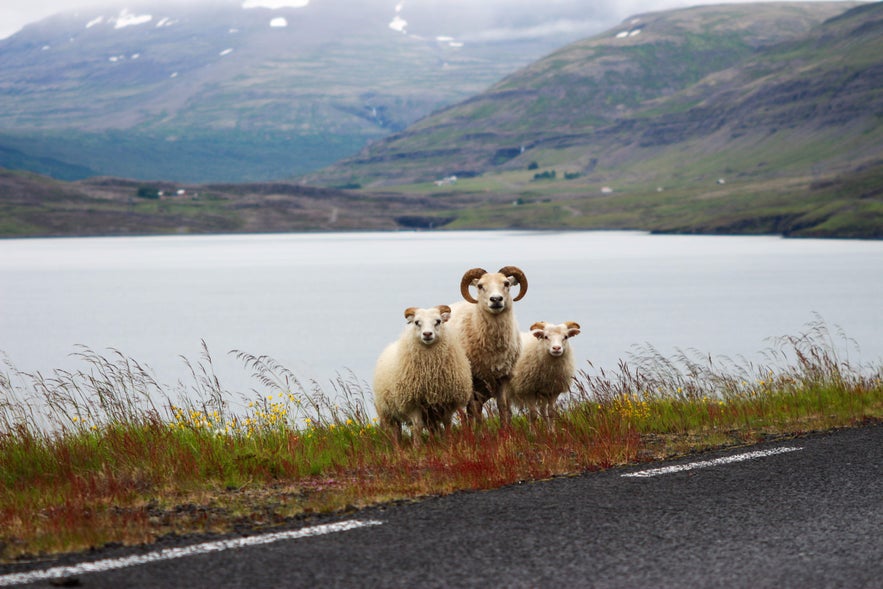
That brings us to ram's testicles, a tricky one to justify, no doubt. Iceland used to be one of the poorest countries in Europe, full of poor farmers who would make the most of anything they could eat. That, naturally, included the testicles of the ram.
To preserve them through the winter, the testicles were soured. Needless to say, fermented sheep testicles are not a common dish anymore.
4. Hot Spring Rye Bread
Let's move on to something a bit tastier. The Icelandic rye bread is very popular in the country. It's a dark bread that's got a very particular taste: it’s slightly sweet.
Nonetheless, it's not a pastry and is mostly eaten on its own with butter, accompanying plokkfiskur fish stew, or hung and smoked lamb (called hangikjot, which we will come to below).
One option for cooking this bread is to put the dough into special wooden casks in the ground close to a hot spring and pick it up the next day. It's absolutely delicious!
5. Hardfiskur (Dried Fish)
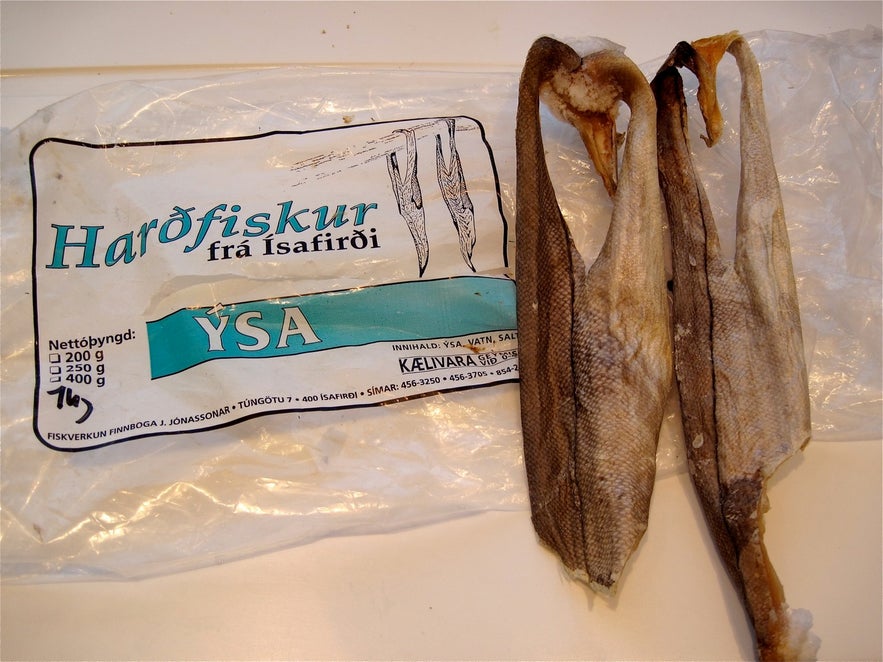 Photo from Wikimedia, Creative Commons, by cogdogblog. No edits made.
Photo from Wikimedia, Creative Commons, by cogdogblog. No edits made.
Another popular food item is the dried fish, usually cod or haddock. This is very popular amongst Icelanders, and some foreigners have enjoyed it too.
It's sort of like a “fish jerky”. Icelanders eat tonnes of this every year with butter on top, as the texture of the fish is very dry, and the butter makes it softer. You need to chew each bite very thoroughly before swallowing it!
In addition, it's very rich in protein. In fact, 100g holds about 80-85% of one's daily protein in it. You will either love it or hate it, but there’s only one way to find out!
6. Svid (Sheep's Head)
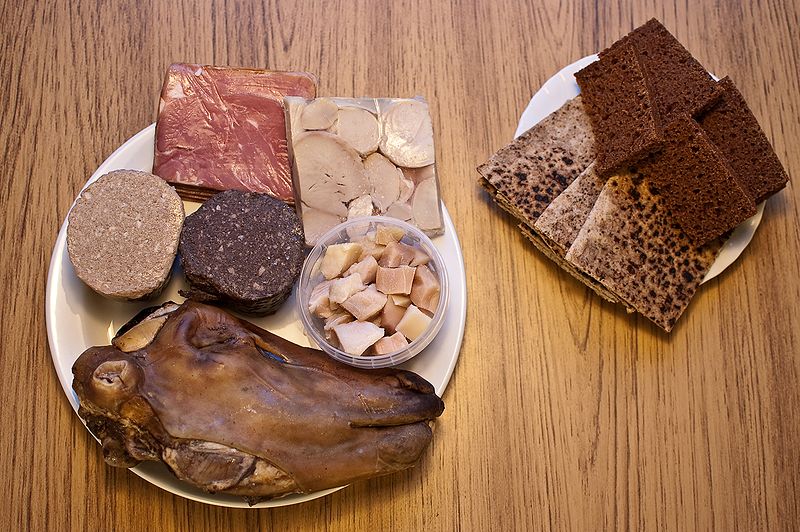
This Icelandic delicacy is a sheep's head. You can find it pre-cooked in a small grocery store called Melabudin in the western part of Reykjavik, or frozen in most supermarkets.
The whole head is eaten, with the exception of the brain (which is considered a delicacy in France). There is debate over what is the tastiest part of the head, with some people saying it’s the cheek or tongue and others claiming the eyes are the best part.
The presentation is mainly what throws people off. However, it tastes exactly like lamb or mutton and is actually rather delicious.
At the cafeteria at the BSI Bus Terminal in Reykjavik, svid is available daily. It’s not on the main menu, but you can always ask for it.
You can also get svidasulta (sheep head jam), which is constructed by chopping up the meat from cooked sheep heads, pressing it into molds, and then cooling it. Svidasulta is eaten as a bread topping.
7. Slatur (Blood Pudding)
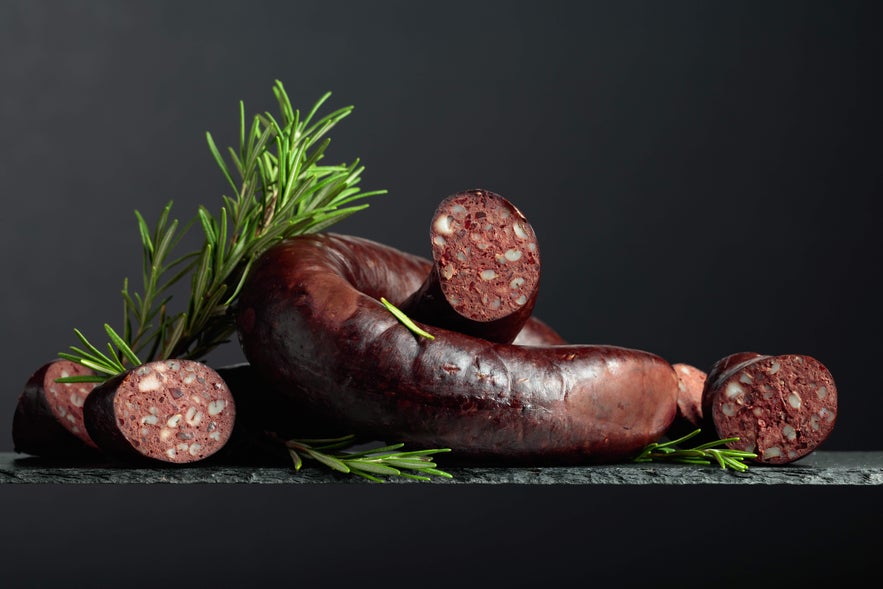 Slatur literally means “slaughter”. It's a dish made out of sheep's innards, blood, and fat. This is a dish that's very regularly served with the sheep's head.
Slatur literally means “slaughter”. It's a dish made out of sheep's innards, blood, and fat. This is a dish that's very regularly served with the sheep's head.
There are two types of slatur: Blodmor (blood pudding) or lifrarpylsa (liver sausage). Blodmor resembles English/Irish black pudding, and lifrarpylsa resembles Scottish haggis, although the Icelandic slatur is much smoother in texture. Some people like to eat their slatur with sugar sprinkled over it.
Blood pudding is also served at many Thorri gatherings, along with sweet rice pudding, which is a slightly odd combination.
8. Hangikjot (Hung & Smoked Meat)
A delicacy that's mostly eaten during Christmas. The meat (lamb or mutton) is smoked, either with birch or dried sheep dung. It is then usually boiled and served either hot or cold in slices with peas, potato mash, and a white sauce called “uppstufur” (similar to bechamel sauce).
Often, a thin cracker-type bread, laufabraud (leaf bread), accompanies it. In recent years, “twice-smoked” meat has become popular, which is eaten raw, much like Italian prosciutto, and it is very tasty.
Day-to-day, you can also buy thin slices of hangikjot in supermarkets to eat as a sandwich topping!
9. Laufabraud (Leaf Bread)
This is a very thin circular “bread,” similar to a poppadom in texture. It is differently flavored from poppadom, though, and often eaten with butter.
The laufabraud is fried in hot oil, but before it's fried, a leaf-like pattern is cut into it, which is often done as a family Christmas tradition. There are many traditional patterns, but this can also be a way for you to show your creative side!
10. Saltfiskur (Salted Fish)
 One of the traditional methods used to preserve food was to salt it. And then I mean plenty of salt.
One of the traditional methods used to preserve food was to salt it. And then I mean plenty of salt.
The fish would be completely covered in salt, which dries up the fish as well.
Before cooking it, it needs to be soaked in water for hours or even 2-3 days, the length depending on how big the fish is, how much salt you want to get rid of, and how often you change the water.
Today, you can buy “lightly salted fish,” which doesn't need to be watered out. That one doesn't give you the same taste or texture as the “properly” salted fish.
Traditionally, the fish would just be boiled and served with potatoes and rye bread, but today, it's popular to cook it in a Spanish or Italian style, with tomatoes and olives, for example.
Icelandic salted cod remains one of Iceland's biggest exports and is a popular delicacy in Portugal, Greece, and Spain.
11. Kaefa (Pate)
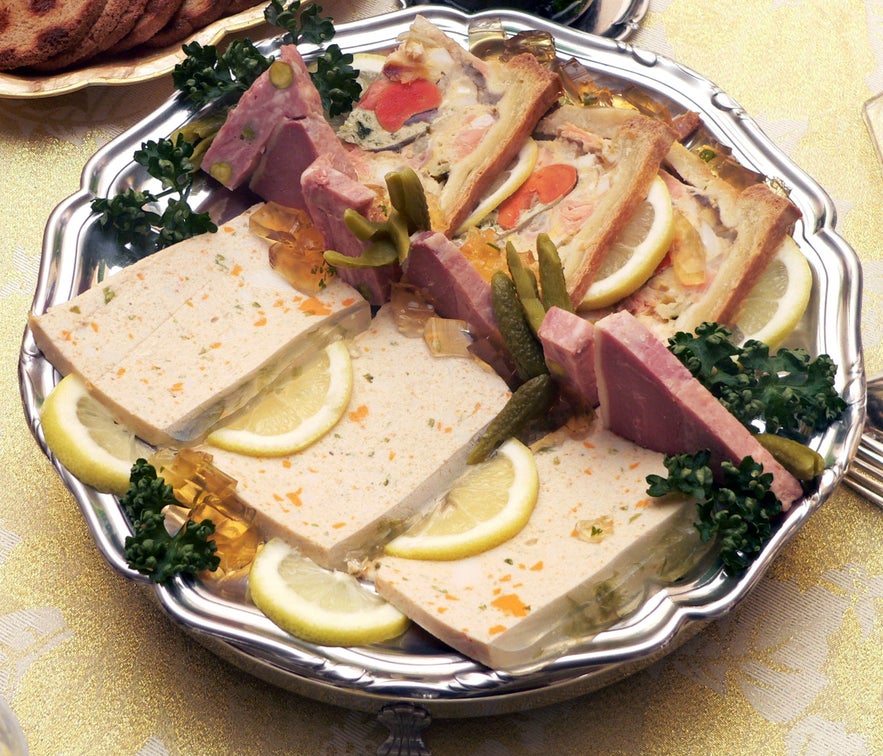
Icelandic pate is a favorite to layer onto bread. The Icelandic kaefa is mainly made out of mutton and is pretty much identical to a pate, but you can get it in various forms, smooth or coarse.
12. Whale
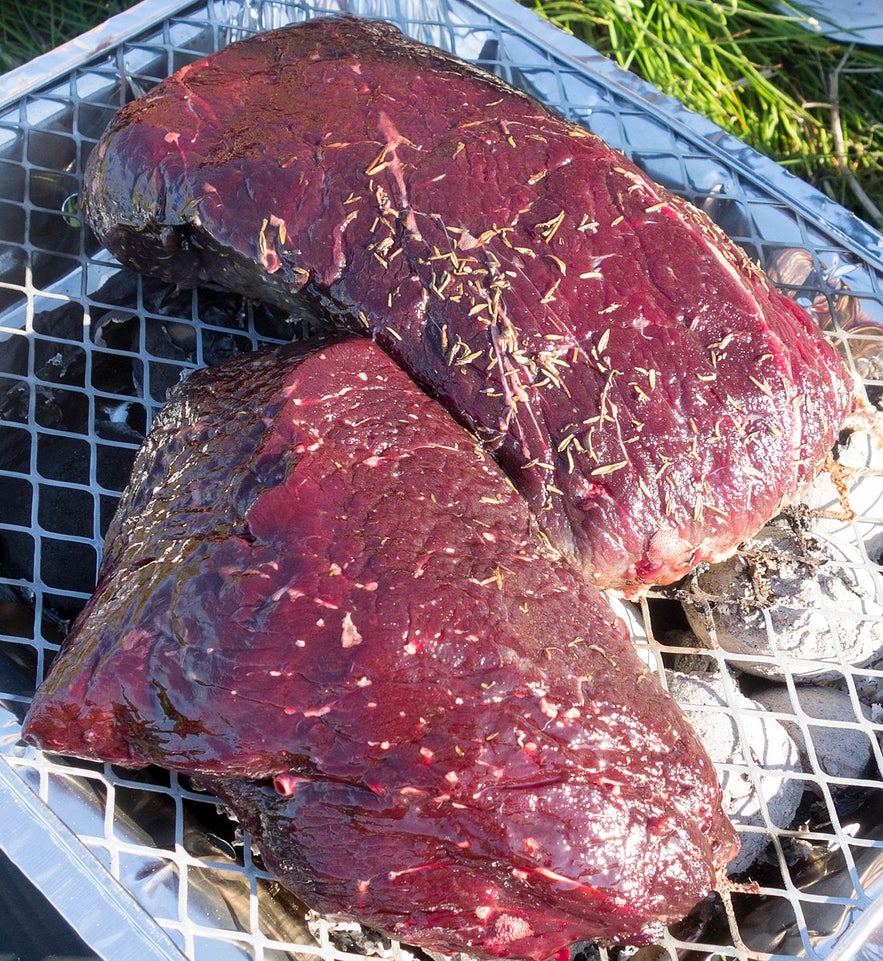 Photo from Wikimedia, Creative Commons, by Kent Wang. No edits made.
Photo from Wikimedia, Creative Commons, by Kent Wang. No edits made.
The whale consumed in Iceland is the Minke whale, but it's very controversial among locals. Guide to Iceland does not support the hunting of endangered whale species in any region.
While eating whale meat has deep roots in Icelandic tradition, especially during times when resources were scarce, it is not a necessary part of modern Icelandic cuisine.
In the past, a beached whale was considered a rare and valuable gift from nature, so much so that the Icelandic word hvalreki, meaning “beached whale,” came to symbolize unexpected good fortune.
That said, whale meat remains available in some Icelandic restaurants and can be found in the frozen aisle of a few local supermarkets. If you’re curious, it’s typically served lightly grilled or raw as sashimi with soy sauce.
If you're interested in whales, the most responsible and rewarding way to appreciate them is through Iceland’s whale-watching industry.
By choosing whale-watching tours over a whale dish, visitors support sustainable tourism and help protect these magnificent animals in their natural environment.
Top Icelandic Whale Watching Tours
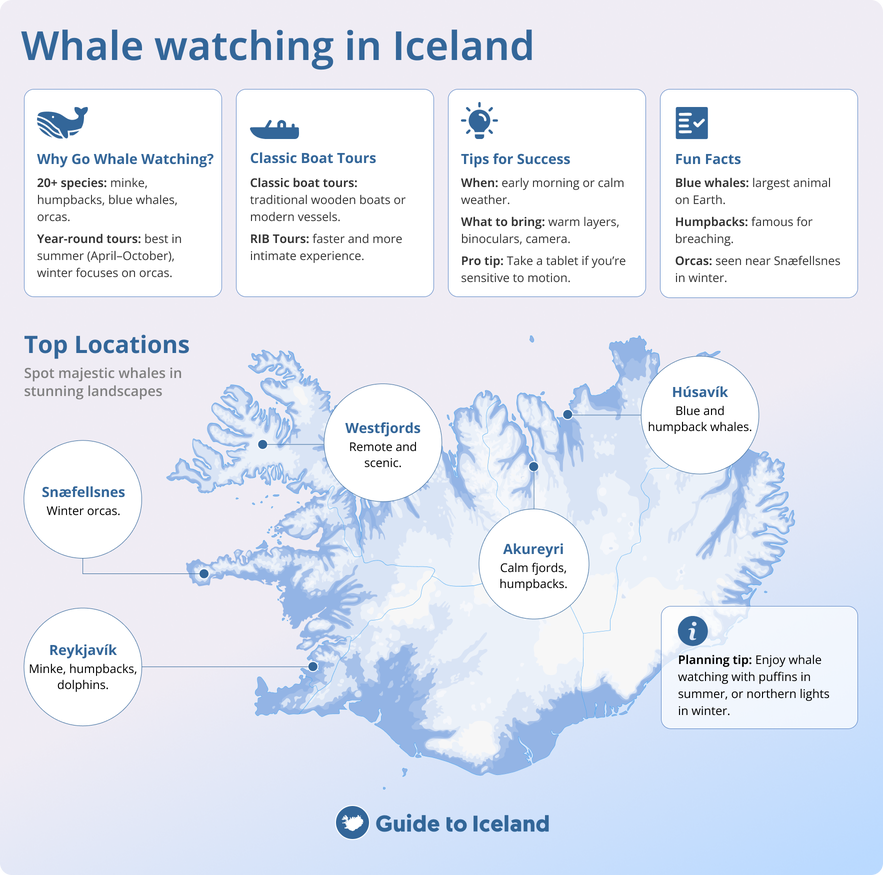
- The Original Husavik Whale Watching Tour — Visit Husavik, the whale-watching capital of Iceland, and search for whales on a traditional oak boat.
- The Whale-Watching Tour from Reykjavik — On this whale-watching tour, you'll sail out to Reykjavik's breathtaking Faxafloi Bay and see stunning geographic features.
- Whale Watching Tour with Transfer from Akureyri — After leaving from Akureyri's floating pier, you'll board a high-speed ship in search of whales.
13. Hvalspik (Blubber)
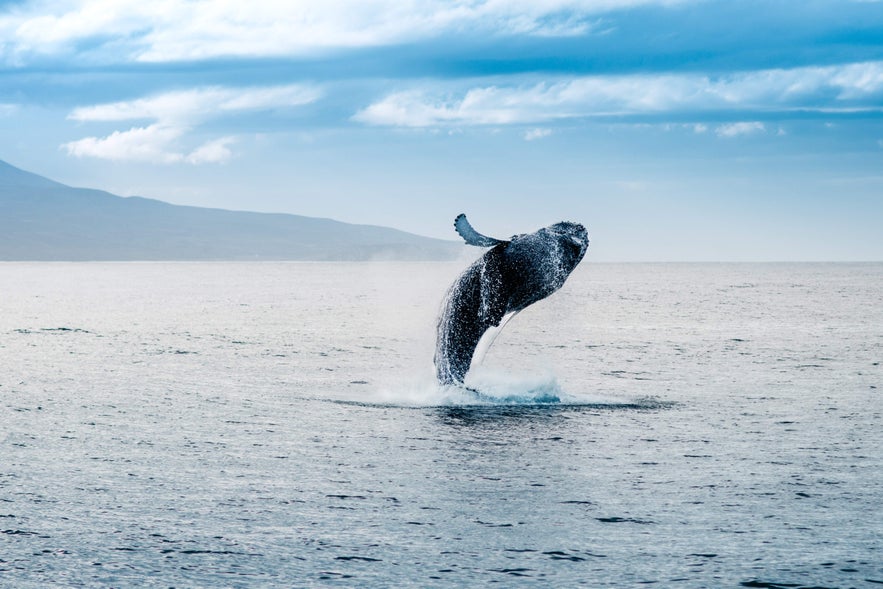
Hvalspik means “whale fat”. This is boiled and cured in lactic acid. It's basically blubber, and it used to be one of Iceland's main delicacies, although you'd be hard-pressed to find anyone who eats it today.
14. Gellur (Cod Tongues)
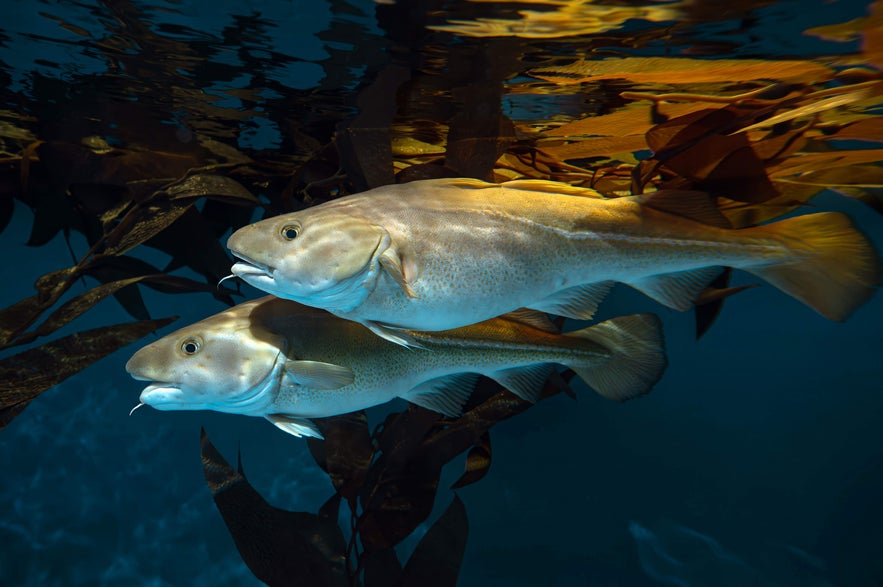
When cooked in an exciting way, such as au gratin, gellur can be quite tasty. On the other hand, a traditional method of cooking gellur is just by boiling them, which is not as tasty. Unless you ask your Icelandic grandfather.
Gellur are often mistaken to be fish tongues, but actually, they're a fleshy, white, slimy, triangular muscle behind and under the tongue. All good fishmongers used to have them, although they're a bit harder to come by these days. In old Icelandic culture, gellur were believed to be an aphrodisiac, and is also a slang term for a stylish, beautiful woman.
15. Kutmagar (Fish Stomach)
 Kútmagar is a traditional Icelandic dish made from a fish's stomach that is stuffed with a mixture of blood, ground offal (like liver and lungs), suet (fat), and either rye or oat meal.
Kútmagar is a traditional Icelandic dish made from a fish's stomach that is stuffed with a mixture of blood, ground offal (like liver and lungs), suet (fat), and either rye or oat meal.
The name "kútmagi" loosely translates to “stuffed belly.” It’s similar in concept to haggis in Scotland, reflecting a time when Icelanders used every part of the animal for food out of necessity.
Kútmagar were typically made in the autumn, shortly after the annual slaughter season (sláturtíð), when fresh ingredients from the sheep were most readily available. The dish was then preserved—by boiling, drying, or smoking—and eaten during the winter months, especially during the midwinter time of Thorri.
Today, kútmagi is rarely eaten outside of “þorrablót” feasts, where Icelanders honor their culinary heritage with a variety of old-time dishes. While it's no longer part of everyday cuisine, it survives as a cultural symbol and curiosity for adventurous eaters.
16. Lundi (Puffin)
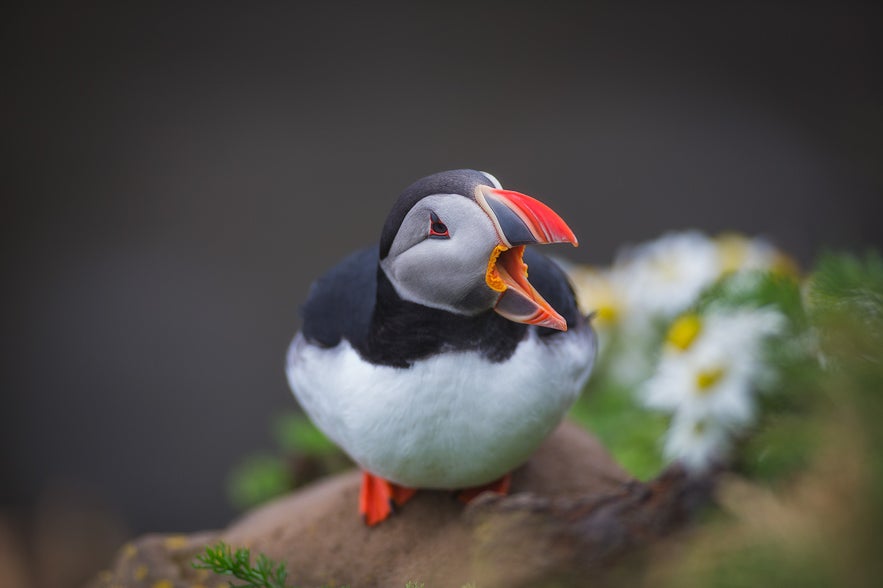 Puffin can both be boiled in milk sauce or smoked. Smoked puffin is considered a proper delicacy found in restaurants all over the country. Puffin is a national dish in the Westman Islands, where the largest puffin colony in Iceland is.
Puffin can both be boiled in milk sauce or smoked. Smoked puffin is considered a proper delicacy found in restaurants all over the country. Puffin is a national dish in the Westman Islands, where the largest puffin colony in Iceland is.
Top Puffin Tours in Iceland
 Aren't interested in eating lundi? Instead, check out this selection of fun puffin birdwatching tours.
Aren't interested in eating lundi? Instead, check out this selection of fun puffin birdwatching tours.
- Thrilling 9-Hour Vestmannaeyjar and Puffins Guided Tour from Reykjavik — On this exciting nine-hour tour, you'll travel to the stunning Westman Islands to see puffins in their natural habitat.
- Small-Group 12-Hour Westman Islands Puffins and Volcano Day Tour from Reykjavik — Get a chance to photograph puffins and experience a stunning Icelandic archipelago during this small-group excursion.
- Family-Friendly Puffin Boat Tour from Reykjavik — If you're searching for an enjoyable activity to add to your itinerary, this Reykjavik puffin-watching tour is a perfect fit.
17. Kjotsupa (Meat Soup)
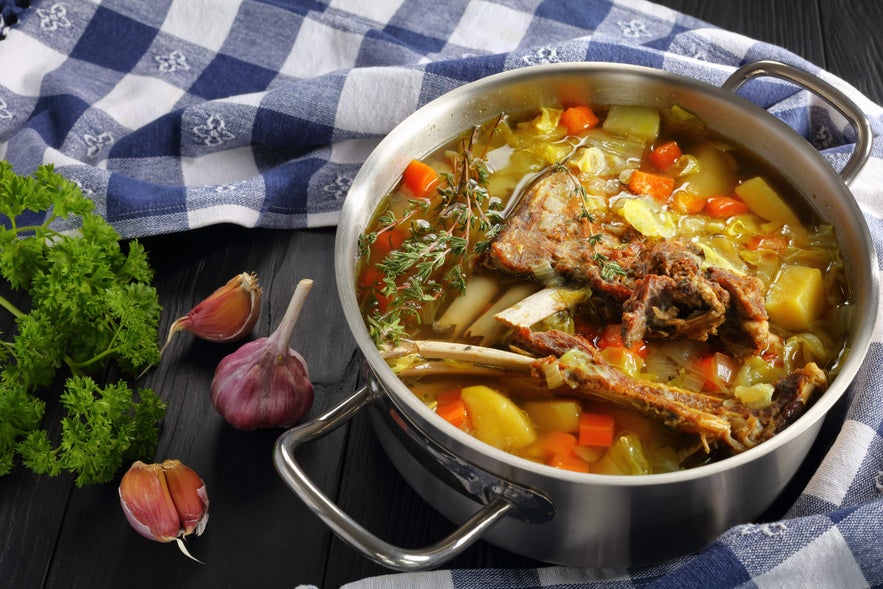 The traditional Icelandic meat soup, known as kjötsúpa, is a warm, comforting, and surprisingly flavorful dish that has been a staple of Icelandic home cooking for centuries.
The traditional Icelandic meat soup, known as kjötsúpa, is a warm, comforting, and surprisingly flavorful dish that has been a staple of Icelandic home cooking for centuries.
Made with tender chunks of lamb, often including bone for extra richness, it is simmered slowly with root vegetables like potatoes, carrots, onions, and swede (rutabaga). It also includes herbs and sometimes rice or rolled oats to thicken the broth.
Though simple, it is deeply satisfying, especially on a cold day, and showcases the quality of Icelandic lamb, which grazes freely on wild grass and herbs.
Kjötsúpa is not just a nostalgic meal from the past. It is still very much alive in modern Iceland.
You will find it served everywhere from gas stations to cozy cafés to fine dining restaurants, making it one of the most commonly seen and widely loved traditional dishes in the country. It is a must-try for anyone wanting a true taste of Iceland.
18. Fiskisupa (Fish Soup)
Icelandic fish or seafood soup varies from one house to the next. The fish soup is most commonly cream-based, but it can vary greatly based on family recipes. For example, I make a special recipe from my mother that includes a bunch of blue cheese and curry.
For a fish soup recommendation, I had one in a restaurant in Isafjordur which is a close second best I've had! There is such an abundance of fresh fish and seafood on offer in Iceland that you're sure to taste the best fish or lobster soup of your life during a visit.
19. Skyr
 Even if it's not considered nasty food like some of the other dishes on this plate, no list of traditional Icelandic food would be complete without mentioning “Skyr.” It's one thing pretty much everyone takes an instant liking to.
Even if it's not considered nasty food like some of the other dishes on this plate, no list of traditional Icelandic food would be complete without mentioning “Skyr.” It's one thing pretty much everyone takes an instant liking to.
Skyr is a low-fat dairy product that resembles yogurt but is tecnically a type of cheese. It's very rich and creamy but still contains hardly any fat. It's a product that's unique to Iceland and is very popular among both locals and travelers.
Many desserts have been made from skyr, and recently, it's been making its way abroad. You can now buy skyr in supermarkets across the world, including the United States, United Kingdom, and our Nordic neighboring countries.
Top Food Experiences in Iceland
 If you want Iceland's unique cuisine to be a part of your trip, there are a multitude of food and drink tours to partake in.
If you want Iceland's unique cuisine to be a part of your trip, there are a multitude of food and drink tours to partake in.
- Reykjavik Food Walk Tour — As you sample food from 6 fantastic locations, you'll learn about the unique history and culture of Reykjavik, Iceland's beautiful capital.
- Small-Group Food Walking Tour in the Heart of Reykjavik — Taste iconic Icelandic cuisine at several specially selected venues on this 3-hour culinary tour of Reykjavik.
- Reykjavik Beer & Schnapps Guided Walking Tour — During this lively culinary tour, you'll explore Iceland's capital and enjoy a variety of beer and schnapps along the way.
FAQs About Icelandic Food
Here are some frequently asked questions about traditional Icelandic food.
When Do Icelanders Have Dinner?
Many Icelanders commonly have dinner between 6:00 and 8:00 PM. Evening meals are seen as a time for families to reconnect after the day.
Why Are There Fewer Fruits in Iceland?
The scarcity of fruits in Iceland can be traced to its cold climate and limited farmable land. In addition, importing fresh produce is expensive due to the island’s remote location in the North Atlantic. As a result, the variety and availability of fruits are more restricted than in other parts of the world.
How Is the Icelandic Hot Dog Different?
The Icelandic hot dog, or “pylsa,” stands out because it’s made mostly from lamb, unlike the typical pork or beef versions found elsewhere. It’s traditionally topped with a unique combination of crispy onions, raw onions, sweet brown mustard, ketchup, and remoulade, which is an Icelandic sauce with mayo and herbs. This blend of ingredients creates a flavor profile that’s savory and distinct from other hot dogs.
Does Iceland Have a National Food?
Yes, hakarl, fermented shark, is considered a national dish. This traditional food has deep roots in Icelandic culture and is often served during the midwinter festival. While hákarl is symbolic of Icelandic heritage, it’s more of a cultural delicacy than an everyday meal.
Does Iceland Have Any Famous Desserts?
Iceland is known for several unique desserts. Although technically a dairy product similar to yogurt, skyr is often sweetened and served with fruit or jam, making it a popular dessert. Another beloved treat is kleina, a twisted doughnut-like pastry that is deep-fried and commonly enjoyed with coffee.
Try Icelandic Cuisine During Your Trip to Iceland
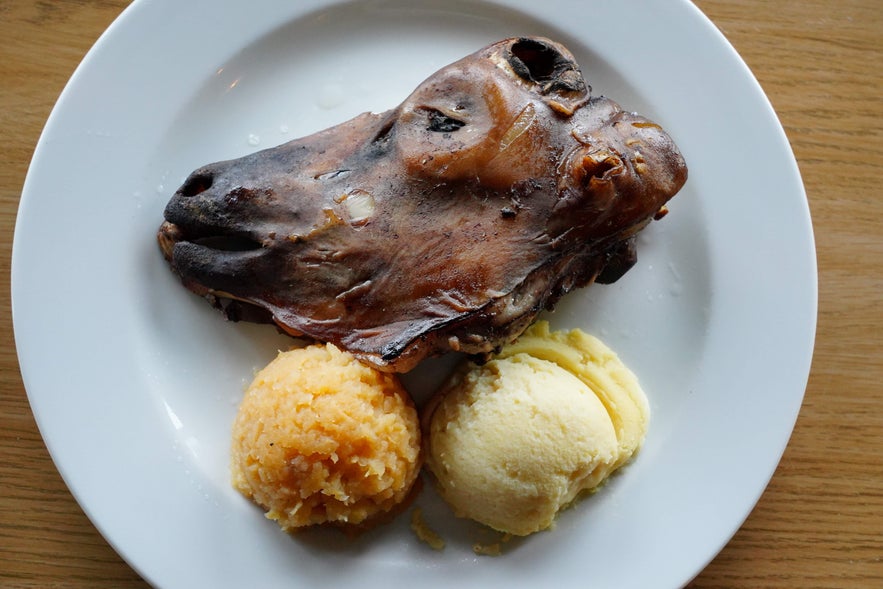 While some may consider Icelandic delicacies disgusting, looking at pictures alone doesn't do them justice. Instead, it's not a bad idea to try weird Icelandic foods yourself and come to your own conclusions. While fermented shark might not be everyone's cup of tea, Icelandic cuisine has something for everyone.
While some may consider Icelandic delicacies disgusting, looking at pictures alone doesn't do them justice. Instead, it's not a bad idea to try weird Icelandic foods yourself and come to your own conclusions. While fermented shark might not be everyone's cup of tea, Icelandic cuisine has something for everyone.
Did you like our article on the most disgusting food in Iceland? What delicacies did you try during your time here? Did you like the food or find it predictably foul? Make sure to leave your thoughts and questions in the comment section below.

